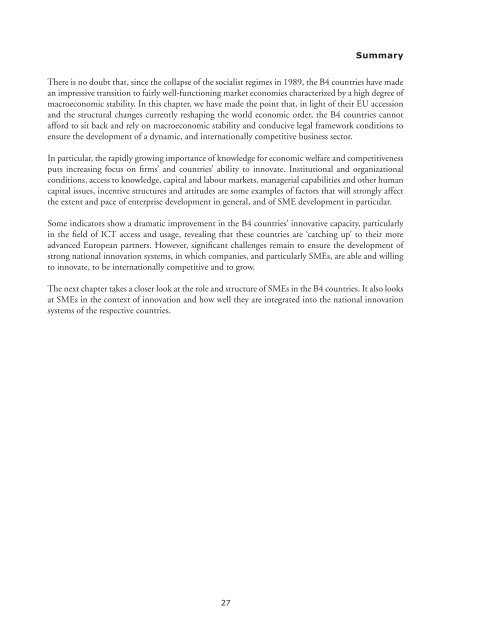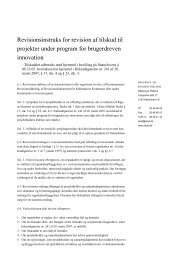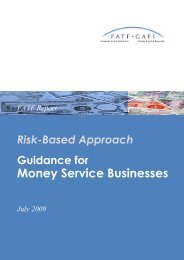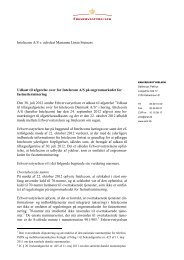Box 3: The Indicator ProblemExist<strong>in</strong>g <strong>in</strong>novation <strong>in</strong>dicators <strong>and</strong> <strong>in</strong>novation surveys display considerable weaknesses,especially for economies <strong>in</strong> a development or transition stage but also <strong>in</strong> <strong>the</strong> case of developedcountries (see, e.g. God<strong>in</strong> (2003), <strong>and</strong> Salazar <strong>and</strong> Holbrook (2003)). Innovation surveystend to measure activities <strong>and</strong> <strong>in</strong>put ra<strong>the</strong>r than output. R&D is a measure add<strong>in</strong>g up severaldifferent k<strong>in</strong>ds of activities <strong>and</strong>, it should be underl<strong>in</strong>ed, is not equivalent to <strong>in</strong>novation.Ano<strong>the</strong>r aspect is that <strong>in</strong>novation surveys fail to capture organizational, process <strong>and</strong> services<strong>in</strong>novation, or <strong>in</strong>novation <strong>in</strong> <strong>the</strong> public sector (God<strong>in</strong> (2003)). F<strong>in</strong>ally, while <strong>in</strong>novation policytoday recognizes <strong>the</strong> importance of effective l<strong>in</strong>kages <strong>and</strong> networks, “<strong>in</strong>novation surveys throwlittle light onto how <strong>the</strong>se networks are created, function <strong>and</strong> develop over time” (Salazar <strong>and</strong>Holbrook (2003)).Ano<strong>the</strong>r significant problem which is not unique to <strong>in</strong>novation <strong>in</strong>dicators, but which is highlyrelevant for policymakers seek<strong>in</strong>g to design effective <strong>in</strong>novation policies, is <strong>the</strong> fact that <strong>the</strong>y arenot suitable for economies characterized by bipolarities, <strong>in</strong> terms of large regional differences orlarge spreads regard<strong>in</strong>g <strong>in</strong>novativeness, as is <strong>the</strong> case <strong>in</strong> many of <strong>the</strong> EU Accession Countries.In <strong>the</strong>se countries, both regional disparities <strong>and</strong> <strong>the</strong> differences between <strong>the</strong>ir modern <strong>and</strong>traditional segments tend to be considerably larger than for <strong>the</strong> o<strong>the</strong>r OECD countries.The available <strong>in</strong>novation statistics can be mislead<strong>in</strong>g, s<strong>in</strong>ce <strong>the</strong>y cannot reflect <strong>the</strong>se largediscrepancies with<strong>in</strong> <strong>the</strong> countries <strong>in</strong> question, but capture only <strong>the</strong> average - composed ofvery highly developed, competitive, <strong>in</strong>novative firms <strong>and</strong> sectors on <strong>the</strong> one h<strong>and</strong>, <strong>and</strong> verytraditional firms <strong>and</strong> sectors with low productivity <strong>and</strong> <strong>in</strong>novative capacities, on <strong>the</strong> o<strong>the</strong>rh<strong>and</strong>.The more homogenous a country is, <strong>in</strong> terms of economic development <strong>and</strong> <strong>in</strong>novativecapacity, <strong>the</strong> more suitable <strong>the</strong> exist<strong>in</strong>g <strong>in</strong>novation <strong>in</strong>dicators <strong>and</strong> surveys. In order fortransition economies <strong>and</strong> economies with high regional <strong>and</strong> segment disparity to be able tomake sound <strong>in</strong>novation policy decisions, <strong>the</strong>re is a clear need for <strong>the</strong> development of new<strong>and</strong> / or improved <strong>in</strong>dicators of <strong>in</strong>novation. In particular, countries, such as <strong>the</strong> B4 countries,should work towards, <strong>and</strong> could benefit considerably from, jo<strong>in</strong>t <strong>in</strong>itiatives aimed at improv<strong>in</strong>gregional <strong>in</strong>novation <strong>in</strong>dicators.Source: Andersson et.al. (2004b)26
SummaryThere is no doubt that, s<strong>in</strong>ce <strong>the</strong> collapse of <strong>the</strong> socialist regimes <strong>in</strong> 1989, <strong>the</strong> B4 countries have madean impressive transition to fairly well-function<strong>in</strong>g market economies characterized by a high degree ofmacroeconomic stability. In this chapter, we have made <strong>the</strong> po<strong>in</strong>t that, <strong>in</strong> light of <strong>the</strong>ir EU accession<strong>and</strong> <strong>the</strong> structural changes currently reshap<strong>in</strong>g <strong>the</strong> world economic order, <strong>the</strong> B4 countries cannotafford to sit back <strong>and</strong> rely on macroeconomic stability <strong>and</strong> conducive legal framework conditions toensure <strong>the</strong> development of a dynamic, <strong>and</strong> <strong>in</strong>ternationally competitive bus<strong>in</strong>ess sector.In particular, <strong>the</strong> rapidly grow<strong>in</strong>g importance of knowledge for economic welfare <strong>and</strong> competitivenessputs <strong>in</strong>creas<strong>in</strong>g focus on firms’ <strong>and</strong> countries’ ability to <strong>in</strong>novate. Institutional <strong>and</strong> organizationalconditions, access to knowledge, capital <strong>and</strong> labour markets, managerial capabilities <strong>and</strong> o<strong>the</strong>r humancapital issues, <strong>in</strong>centive structures <strong>and</strong> attitudes are some examples of factors that will strongly affect<strong>the</strong> extent <strong>and</strong> pace of enterprise development <strong>in</strong> general, <strong>and</strong> of SME development <strong>in</strong> particular.Some <strong>in</strong>dicators show a dramatic improvement <strong>in</strong> <strong>the</strong> B4 countries’ <strong>in</strong>novative capacity, particularly<strong>in</strong> <strong>the</strong> field of ICT access <strong>and</strong> usage, reveal<strong>in</strong>g that <strong>the</strong>se countries are ‘catch<strong>in</strong>g up’ to <strong>the</strong>ir moreadvanced European partners. However, significant challenges rema<strong>in</strong> to ensure <strong>the</strong> development ofstrong national <strong>in</strong>novation systems, <strong>in</strong> which companies, <strong>and</strong> particularly <strong>SMEs</strong>, are able <strong>and</strong> will<strong>in</strong>gto <strong>in</strong>novate, to be <strong>in</strong>ternationally competitive <strong>and</strong> to grow.The next chapter takes a closer look at <strong>the</strong> role <strong>and</strong> structure of <strong>SMEs</strong> <strong>in</strong> <strong>the</strong> B4 countries. It also looksat <strong>SMEs</strong> <strong>in</strong> <strong>the</strong> context of <strong>in</strong>novation <strong>and</strong> how well <strong>the</strong>y are <strong>in</strong>tegrated <strong>in</strong>to <strong>the</strong> national <strong>in</strong>novationsystems of <strong>the</strong> respective countries.27
- Page 1 and 2: Sylvia Schwaag SergerEmily HanssonC
- Page 4 and 5: About the International Organisatio
- Page 7: PREFACEAccession to the Single Mark
- Page 10 and 11: enterprise development. There are n
- Page 12 and 13: BOXESBox 1: The ‘Knowledge-Based
- Page 15 and 16: INTRODUCTIONAfter more than 10 year
- Page 17 and 18: CHAPTER 1: FROM STABILISATION TO IN
- Page 19: increased competitive pressure as B
- Page 22 and 23: Box 2: On Innovation and Innovation
- Page 24 and 25: Table 5: GDP Growth 1995-2003 in Se
- Page 26 and 27: Table 7: Relative Strengths and Wea
- Page 31 and 32: CHAPTER 2:BALTIC SMEs - AGENTS OF F
- Page 33 and 34: Table 9: Average Annual Growth of S
- Page 35 and 36: Box 4: Overview of Selected Multina
- Page 37 and 38: The Role of SMEs in Transitional Ec
- Page 39 and 40: e to the potential advantage of the
- Page 41 and 42: A common measurement of business ac
- Page 43 and 44: Figure 8: Labour Productivity per P
- Page 45 and 46: Figure 10: Employment in Med/Hi-tec
- Page 47 and 48: Summing up, there are fewer economi
- Page 49 and 50: Overall, SMEs tend to lack the fina
- Page 51 and 52: Figure 12: Enterprises with Innovat
- Page 53 and 54: Figure 14: Proportion of Enterprise
- Page 55 and 56: Table 14: Barriers to Innovation fo
- Page 57 and 58: Some interesting examples of cluste
- Page 59 and 60: CHAPTER 3:POLICIES PROMOTING SMEs A
- Page 61 and 62: National governments themselves wil
- Page 63 and 64: Institutional StructureIn all of th
- Page 65 and 66: EU countries (innovation relay cent
- Page 67 and 68: LITHUANIAAgency/OrganisationLithuan
- Page 69 and 70: From the private sector, the chambe
- Page 71 and 72: On the whole, the B4 have relativel
- Page 73 and 74: LITHUANIAProgramme/Policy DocumentI
- Page 75 and 76: Table 19: B4 National Rankings of A
- Page 77 and 78: Box 11: Structural Funds to the Can
- Page 79 and 80:
Box 12: On SMEs and FinancingIt doe
- Page 81 and 82:
examples of evaluations of national
- Page 83 and 84:
CHAPTER 4:CHALLENGES AND RECOMMENDA
- Page 85 and 86:
General challengesBased on our own
- Page 87 and 88:
the above-mentioned channels. 27 On
- Page 89 and 90:
the EU average and particularly wit
- Page 91 and 92:
RecommendationsBased on the challen
- Page 93 and 94:
CHAPTER 5:A VISION OF A NORDIC-BALT
- Page 95 and 96:
addition, they are the most advance
- Page 97 and 98:
countries. One such sign is the rap
- Page 99 and 100:
CONCLUSIONSEU accession will not re
- Page 101 and 102:
REFERENCESAlfonso, Antonio, Ludger
- Page 103 and 104:
European Commission (2003f), Compre
- Page 105 and 106:
Eurostat (2004a), SMEs in the Candi
- Page 107 and 108:
Statistical Office of Estonia (2004
- Page 109 and 110:
APPENDIX I:Agenda for Working Group
- Page 111 and 112:
DAY 2:POLICY SOLUTIONS9:30-10:30 In
- Page 113 and 114:
APPENDIX II:Participants in the IKE
- Page 115 and 116:
APPENDIX III:Conclusions from the I
- Page 117 and 118:
APPENDIX IV:Summary of the Panel se
- Page 119 and 120:
Regarding the role of policymaking,
- Page 121 and 122:
APPENDIX V:Description of Field Stu
- Page 123 and 124:
Mr. Miroslaw MarekMr. Talis Millers
- Page 126:
IKED - International Organisation f
















